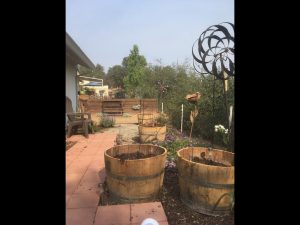By enhancing your backyard ecosystem system, you can provide a refuge and a resting place for birds, bees, butterflies and other wildlife. Fill your yard and garden with the sights and sounds of nature.
Landscape your garden to attract wildlife by planting a mixture of native trees, shrubs and flowers along with your vegetables. The combination will attract and provide for your pollinators and wildlife. The birds offer natural pest control while the bees and butterflies are your gardens pollinators.
The basic element needed to attract local birds, bees, butterflies and beneficial wildlife neighbors is to provide what they need for survival: food, water and shelter.
Suggestions from the University of California, Santa Cruz about keeping a tidy, versus a messy, garden show that there are benefits to the unkept garden, and may even result in insect biodiversity. Planting to attract birds and bees with native plants is a way to do this. The Audubon Society suggests a variety of types of native plantings. For the Sierra foothill area perhaps some of the following:
Birds: shrubs with berries, buckthorn, sunflowers for seeds, salvia for hummers.
Bees: Figwort, rock rose, sage, clover, toyon, larkspur, lavender and clover.
Butterflies: milkweed, thistle, mint, monkey flower, lupine, rudbeckia, Echinacea.
Trees in the area might include oak, buck bush, dogwoods and alder. Providing an ideal habitat involves a combination of food, water, shelter and space arranged to meet the needs of your wildlife. Even a small yard or garden can provide the things needed for them.
Flowers of the same type or color planted in clusters like rings or barrels are going to attract bees and butterflies to return again and again to your garden. Create islands of nectar flowers that help pollinators, feed birds and create nesting materials for the birds and solitary bees. Let things be a little wild by leaving reeds, rocks and wood to provide cover for the critters and a variety of insects. The native plants create a range of habitats and nectar. Other needs are water, such as a small pond, bird bath or saucer filled with rocks and pebbles.
If you put out supplementary feeders, make sure they’re placed where birds can be safely out of range from any lurking danger. Avoid netting which may entangle them. One of my favorites is the hummingbirds who love the brightly-colored tubular flowers like bee balm, hollyhock, columbine or foxglove. You can also add toad abodes (broken pots). Natural reeds and hollows or man-made insect hotels, and yarn or other nesting material for the birds is inviting to the critters. You can also include a bat house in your garden area. Above all avoid the use of chemicals and pesticides.
A wildlife-friendly habitat at your home can replace a water-hungry lawn with plants that attract native birds, butterflies, bees and other wildlife seeking refuge, food, water and cover. These small areas replicate natural pre-urbanized land conditions.
A bit of untouched messiness can result in more diversity. A patch of grass and untouched leaves provides a refuge and hiding place for some beneficial insects. So, sit in your garden chair while you enjoy the refuge you’ve created. As the saying goes, “Stop and smell the roses. “Happy Planting.
Diane Miller is a University of California Cooperative Extension Master Gardener of Tuolumne County.
UCCE Master Gardeners of Tuolumne and Calaveras Counties can answer home gardening questions. Call 209-533-5912 or fill out the questionnaire here. Check out our website here. You can also find them on Facebook.


